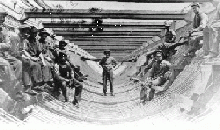In 1881, the Canadian Pacific Railway finally began building the transcontinental railway. The CPR received $25 million and 25 million acres of land in exchange for building the railway through various geographical areas such as muskeg, the Rocky Canadian Shield, the long prairie stretch and a treacherous mountain pass.
The CPR received their land by choosing sections of land on either side of the main railway. The result was a checker-board pattern of CPR owned land. It then sold the undeveloped land to settlers. This system worked well until the CPR encountered the bone-dry lands of Southern Sasketchewan and Alberta. They did not want to saddle themselves with land that would not be profitable. However, William Pearce of the Department of the Interior, and J.S. Dennis of the Government of the Northwest Territories convinced the railway that the land would be fruitful. The CPR wanted to make a profit for itself and its investors, so they decided to develop the area. That way, they could not only sell the land, but increase the traffic along its line. As a local saying went, there was "not enough revenue to pay for the axle grease from Medicine Hat to Calgary".
As final payment for building the railroad, the CPR received a 3 million acre block of land between the west of Calgary and west of Medicine Hat. They divided the 3 million acre block into 3 sections, the Western, Central, and Eastern in 1910.
